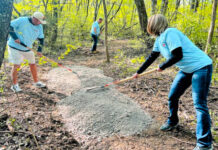“With the increased labor costs, we’re going to need to demand more from our employees, but also to incentivize and train them more,” claims Rick Longnecker, owner of Bud and Blades, a commercial landscape maintenance firm in Olympia, Washington.
Says Richard McCoy, McCoy Horticultural Services, a small New Jersey company that offers a full range of ecologically friendly landscape services: “I’d love to find five or six employees I can rely upon; that would be really great.”
And the beat goes on.
“It’s difficult to find quality employees and not have them poached by other companies,” continues Sam Gookin, sales development manager of Jalco Landscaping in Brea, California.
Ward Summerell, who oversees Advanced Sprinkler & Backflow in Albany, Georgia, is equally concerned about the availability of employable job applicants “Trying to find help is really tough. I’ve got a couple of guys that have been with us a while – we keep them. When it comes time to try to find anybody with any skill set whatsoever, it is difficult,” Summerell shares.
Laura Stroda, marketing director and assistant maintenance manager at Landscape Consultants, LLC, in North Cambria, Kansas, is no less blunt when discussing today’s employee pool. “Though referrals and online job boards have led to some success, at the end of the day, the biggest issue is finding qualified people. Qualified applicants are hard to find,” says Stroda.
OK, we get it.
Just about everybody could use a few more good hands now that the season is in full bloom. But, that’s not all that these companies — each based in a different region of the United States and each specializing in different services — have in common.
Industry mostly optimistic
But the news isn’t all gloom and doom. Far from it.
Each of the companies just mentioned is expecting to increase revenues in what they are predicting will be a more business-friendly environment than that posed by the previous administration in our nation’s Capital.
The tough employee market during a period of relatively good growth prospects is among the biggest takeaways being shared in the recently released Green Industry Benchmark Report compiled by Hindsite Software in St. Paul, Minnesota.
But, at 58 pages and reflecting the opinions of hundreds of green industry business owners and managers from across the United States, the report is loaded with other industry benchmarks, shared through colorful charts and graphs.
Survey findings at a glance
Here is a sampling of other key findings of the report:
- Formal staff training is one way green industry businesses are overcoming the labor shortage. Weekly training has increased 5 percent and employers offering no ongoing employee training have dropped from 18 percent last year to 12 percent this year.
- The labor shortage faced by many green industry businesses may also be impacting margins. Low margins were cited as the biggest issue by 11 percent of respondents, up from 6 percent a year ago.
- 26 percent of respondents saw profits in excess of 20 percent, up 3 percent from a year ago.
- Though only 43 percent of respondents use field service software, it does seem to improve revenue growth. Of the businesses that saw revenue growth in excess of 20 percent last year, more than half used field service software. Compare that to just under 30 percent of those who saw revenue decline last year.
- Businesses that attend four or more educational conferences a year seem to outperform those that attend less than four.
- Though websites were cited as the best source for leads by the most respondents, only about 75 percent of respondents have a website, an unusually low number in the age of the internet.
This year’s Green Industry Benchmark Report also included longer interviews with the five green industry businesses quoted earlier in this article. The interviews delve deeper into individual business issues and successes, practices and advice.
“The Green Industry Benchmark Report has a wealth of aggregated information about green businesses,” explained Chad Reinholz of Hindsite Software. “But we felt like we were missing voices from individual contractors. So we conducted longer interviews to add an individual component to the report.”











![[VIDEO] Dickies®: Discover Workwear That’s Anything But Uniform](https://turfmagazine.com/wp-content/uploads/2023/06/1647663814-4b1a2a7742790a9b1e97a3b963477850192e1d6a9dfba9b07214a77bae25d6e3-d-218x150.jpg)




























![[VIDEO] Dickies®: Discover Workwear That’s Anything But Uniform](https://turfmagazine.com/wp-content/uploads/2023/06/1647663814-4b1a2a7742790a9b1e97a3b963477850192e1d6a9dfba9b07214a77bae25d6e3-d-324x160.jpg)